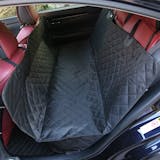A dog slip lead is a popular way to control your dog in a variety of situations. It's especially useful for training sessions, walking your dog, and for use in emergency situations where you need to quickly control your dog's movements. A slip lead consists of a loop of material that tightens around your dog's neck when you pull on one end of the lead. With a little practice, you'll be able to use a slip lead with confidence, ensuring that you can keep your dog under control while also providing them with a sense of freedom.
Step 1: Choosing the Right Size
Before using a dog slip lead, it's important to make sure you have the right size for your dog. If the slip lead is too small, it may be too tight, causing discomfort, and potentially restricting breathing. If the slip lead is too big and loose, it won't be effective in controlling your dog's movements. To pick the right size, consider your dog's weight and breed. Most slip leads come in a range of sizes, so you should be able to find one that's a good fit for your dog.
Step 2: How to position the Slip Lead
Once you have the right size slip lead, it's time to position it correctly on your dog. Hold the slip lead in front of your dog, with the loop end resting against their chest. Bring the loop over your dog's head and position it just behind their ears. Make sure the loop is centered on your dog's neck and that the lead is positioned so that it's not too close to their face.
Step 3: Adjust the Slip Lead
With the slip lead positioned correctly, it's time to adjust the size of the loop. The loop should be snug around your dog's neck, but not too tight. You should be able to fit two fingers between the slip lead and your dog's neck, as a general rule of thumb. If the loop is too loose, it won't be effective in controlling your dog's movements. If the loop is too tight, it may be uncomfortable for your dog, potentially restricting their breathing.
Step 4: Control Your Dog
Once the slip lead is adjusted to the right size, you're ready to control your dog. To do this, gently pull on the end of the lead, which will tighten the loop around your dog's neck. The pressure on the neck will help to control your dog's movements and keep them close to you. If your dog tries to pull away from you, gently pull on the lead to tighten the loop and bring them back to you. It's important to use a gentle and consistent pressure, so your dog knows what you expect from them.
Step 5: Loosen the Slip Lead
When you need to give your dog more freedom, simply loosen the lead by releasing the tension. The slip lead will loosen, giving your dog more room to move. You can use this technique to give your dog a little more freedom to explore, or to let them have a drink of water, for example. When you need to control your dog again, simply pull on the end of the lead to tighten the loop.
Step 6: Remove the Slip Lead
When you're done using the slip lead, it's important to remove it correctly. To do this, simply pull the end of the lead, which will loosen the loop. Slip the loop over your dog's head, and the slip lead is removed. Make sure to store the slip lead in a safe place, so it's ready for use next time.
Slip leads, when used correctly can be a great tool for dog owners. Whether you're using it for training sessions, walking your dog, or controlling your dog in crowded areas, a slip lead can provide a simple and effective way to keep your pet safe and close to you. However, it is important to remember that a slip lead is a form of restraint, and should be used with caution to avoid causing discomfort or harm to your dog. Make sure to choose the right size, position the slip lead correctly, adjust it to fit snugly but not too tight, and use a light, steady pressure when controlling your dog. Remember to also give your dog room to move by loosening the lead and removing it when not in use. With proper use and supervision, a slip lead can be a valuable tool in managing your dog's behavior and ensuring their safety.



Leave a comment
This site is protected by hCaptcha and the hCaptcha Privacy Policy and Terms of Service apply.